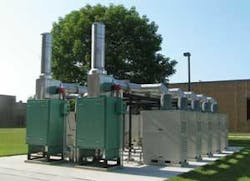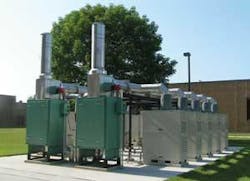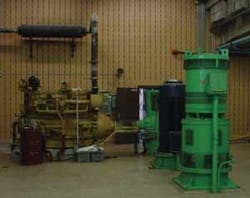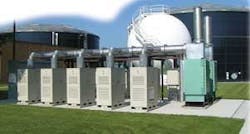Microturbines Turn Digester Gas into Power
When it was time to upgrade the outdated boiler used to heat anaerobic digesters at the City of Sheboygan’s wastewater treatment plant in 2003, the Wisconsin facility’s superintendent wanted to solve two problems at once.
The Sheboygan Regional Wastewater Treatment Plant, which treats up to 15 mgd, had more methane biogas, a by-product of the anaerobic-digestion process, than it knew what to do with.
At the time, gas produced onsite in the anaerobic digestion process had two purposes: to fuel boilers that heat the anaerobic digesters and to fuel an old 500 hp Caterpillar engine that drove an influent pump capable of pumping 11,800 gpm. However, more than 25 percent of the biogas was considered waste and just flared at the plant site. Unfortunately, flared methane gas has a greenhouse-gas impact on the atmosphere 21 times greater than carbon dioxide.
At the same time, the city wanted to reduce electricity costs.
“We wanted something that made sense for the bottom line and the environment,” said Dale Doerr, the plant’s superintendent. “We wanted to get the latest, most efficient system available.”
The search got underway in 2003 when the city completed a study in conjunction with the local utility – Alliant Energy -- and Focus on Energy, a state-wide program that offers grants for energy-saving projects. Focus on Energy funds projects based on first-year energy savings.
The study looked at having the Sheboygan treatment plant create a co-generation system with an Alliant Energy-Wisconsin Power & Light power plant directly south of the treatment facility. The goal was for the wastewater plant to capture waste heat from 85-degree water the Alliant power plant discharged at a rate of 250,000 gallons/minute. The heat would have been used for the treatment plant’s digesters.
“Ultimately that project fell through, but it got us thinking about cogen,” Doerr said. “When microturbines came up, I liked what I heard and wanted to learn more – it sounded like a viable project for us.”
Cogeneration, or combined heat and power (CHP), creates two forms of energy: electricity and heat. A facility can use the electricity produced onsite or sell it back to the local utility, while the heat generated by the engine or turbine is captured and used to heat water, rooms or to dry products in a manufacturing process.
Through research, plant personnel learned that clean-burning, low-emission microturbines are ideally suited to use digester gas as fuel. Microturbines are quiet, don’t vibrate, and don’t have the maintenance issues associated with reciprocating engines.
Eventually, Doerr convinced Sheboygan officials to allocate $500,000 in 2005 to purchase four microturbines.
The project hit a roadblock because of siloxanes in the biogas produced during the wastewater treatment process. Siloxane is extremely abrasive and can damage internal microturbine components or reduce overall efficiency.
Again, the project was scrapped. But a determined Doerr continued to look for a solution. He contacted Unison Solutions, a Dubuque, IA, firm that specializes in biogas conditioning systems and on-site power plants that use microturbine systems.
Innovative Agreement
Unison principals Dave Broihahn and Jan Scott are former Alliant executives who have developed systems for wastewater treatment plants and other facilities throughout the Midwest. Working together, Unison and Alliant came up with an out-of-the-box proposal for the city – Alliant would purchase 10 C30 (30-kilowatt) microturbines from Capstone Turbine, pay for electrical connections from the wastewater plant to the electrical grid, purchase a gas-cleaning system that removes moisture and siloxanes from the raw methane gas and purchase a gas-compression system that compresses the methane gas fed to the microturbines.
In exchange, the city agreed to purchase from Alliant all electricity the microturbines produce, install a heat-recovery module to capture the waste heat and provide the methane fuel for the microturbines. In addition, the city will purchase the entire microturbine system in coming years at a reduced price.
A key benefit of the agreement: the city reaps the financial and societal benefits of producing green/renewable energy. For every megawatt of renewable energy the microturbines create, the Sheboygan Regional Wastewater Treatment Plant receives one Renewable Energy Credit, which the plant can then sell and earn money.
The project got the go-ahead in December 2005 and the 10 Capstone C30 microturbines were installed and running in February 2006.
null
Electricity & Heat
Today, the microturbines have a dual purpose: they generate up to 300 kW of electrical power (2,300 megawatts per year) and produce waste heat that maintains the proper 95-degree temperature in the digesters. The waste heat also is used to heat the plant buildings in the winter.
The microturbines can recover 1 million BTUs of heat per hour, or about 73,000 therms per year – enough heat to keep 60 Sheboygan homes warm each year.
“In 2007, the system produced 1,681 megawatts of electricity valued at $121,000, and 61,000 terms of biogas valued at nearly $57,000,” Doerr said.
In 2007, the wastewater treatment plant also sold 2,076 Renewable Energy Credits for $6,540 because of the green energy the microturbines produced. In total in 2007, the plant received more than $33,600 in revenues thanks to energy the Capstone microturbines produced.
“I think outside the box,” Doerr said “My electricity bill isn’t any higher today than it was five years ago but utility rates are up 105 percent on average. We’re producing very clean energy onsite and recovering the heat. My goal is to keep costs down. This CHP system with microturbines is the answer to helping the environment and keeping costs down.”
Sheboygan’s new system has received attention from across Wisconsin, neighboring states and as far away as Ecuador and Chile, with visitors regularly coming to the plant to learn about the system. WW



